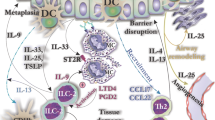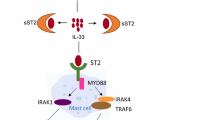Abstract
Mast cells not only function as effector cells but also influence nearly every other cell involved in causing allergic rhinitis. Mast cell-derived mediators such as histamine, bradykinin, tryptase, and the arachidonic acid derivatives produce the symptoms of the early-phase reaction of allergic rhinitis and also attract and activate other leukocytes involved in the latephase reaction. In addition, activated mast cells are known to secrete a number of cytokines, both preformed and newly synthesized, that can modulate T- and B-cell function, propagate the early- and late-phase reactions, and contribute to tissue remodeling. Most currently available therapies work by antagonizing the mediators secreted by mast cells and other leukocytes. With the possible exception of immunotherapy, these therapies do not provide long-term protection against allergic disorders. Exciting new developments in gene-based therapies seem promising in both reducing and reversing the development of allergic rhinitis.
Similar content being viewed by others
References and Recommended Reading
Mekori YA, Metcalfe DD: Mast cell-T cell interactions. J Allergy Clin Immunol 1999, 104:517–523. Through direct interaction by cellular adhesion molecules or via the action of cytokines, mast cells and T cells can influence each other. This article helps clarify the complex relationship between these two key cell types in allergic rhinitis.
Grutzkau A, Kruger-Krasagakes S, Baumeister H, et al.: Synthesis, storage and release of vascular endothelial growth factor/ vascular permeability factor (VEGF/VPF) by human mast cells: implications for the biological significance of VEGF206. Mol Biol Cell 1998, 9:875–884.
Kendall JC, Li XH, Galli SJ, Gordon JR: Promotion of mouse fibroblast proliferation by IgE-dependent activation of mouse mast cells: role for mast cell tumor necrosis factor _ and transforming growth factor b. J allergy Clin Immunol 1997, 99:113–123.
Lindstedt KA, Kokkonen JO, Kovanen PT: Regulation of the activity of secreted human lung mast cell tryptase by mast cell proteoglycans. Biochim Biophys Acta 1998, 1425:617–627.
Schneider E, Rolli-Derkinderen M, Arock M, Dy M: Trends in histamine research: new functions during immune responses and hematopoiesis. Trends Immunol 2002, 23:255–263. This article discusses the four histamine receptor subtypes, including the newly discovered H4 receptor. The authors shed new light on the role of histamine in various immune responses, as well as hematopoesis.
Bachert C: The role of histamine in allergic disease: reappraisal of its inflammatory potential. Allergy 2002, 57:287–296. Histamine is a key mast cell-derived mediator in allergic rhinitis. In this article, the numerous effects of this mediator on various inflammatory cells, as well as epithelial and endothelial cells, are reviewed.
Okamoto Y, Shirotori K, Kudo K, et al.: Cytokine expression after topical administration of substance P to human nasal mucosa: the role of substance P in nasal allergy. J Immunol 1993, 151:4391–4398.
Farber HW, Weller PF, Rounds S, et al.: Generation of lipid neutrophils chemoattractant activity by histamine-stimulated cultured endothelial cells. J Immunol 1986, 137:2918–2924.
Asako H, Kurose I, Wolf R, et al.: Role of H1 receptors and Pselectin in histamine-induced leukocyte rolling and adhesion in post-capillary venules. J Clin Invest 1994, 93:1508–1515.
Temkin V, Kantor B, Weg V, et al.: Tryptase activates the mitogen-activated protein kinase/activator protein-1 pathway in human peripheral blood eosinophils, causing cytokine production and release. J Immunol 2002, 169:2662–2669.
Imamura T, Dubin A, Moore W, et al.: Induction of vascular permeability enhancement by tryptase: dependence on activation of prekallikrein and direct release of bradykinin from kininogens. Lab Invest 1996, 74:861–870.
Cairns JA, Walls AF: Mast cell tryptase stimulates the synthesis of type I collagen in human fibroblasts. J Clin Invest 1997, 99:1313–1321.
Cairns JA, Walls AF: Mast cell tryptase is a mitogen for epithelial cells: stimulation of IL-8 production and ICAM expression. J Immunol 1996, 156:275–283.
Thabrew H, Cairns JA, Walls AF: Mast cell tryptase is a growth factor for human airway smooth muscle cells [abstract]. J Allergy Clin Immunol 1996, 97:969.
Sommerhof CP, Caughey GH, Finkbeiner WE, et al.: Mast cell chymase: a potent secretagogue for airway gland serous cells. J Immunol 1989, 142:2450–2456.
Sage H, Woodbury RG, Bornstein P: Structural studies on human type IV collagen. J Exp Med 1979, 254:9893–9900.
Proud D, Macglashan DW Jr, Newball HH, et al.: Immunoglobulin E-mediated release of a kininogenase from purified human lung mast cells. Am Rev Respir Dis 1985, 132:405–408.
Proud D, Reynolds CJ, Lacapra S, et al.: Nasal provocation with bradykinin induces symptoms of rhinitis and a sore throat. Am Rev Respir Dis 1988, 137:613–616.
Walsh LJ, Trinchieri G, Waldorf HA, et al.: Human dermal mast cells contain and release tumor necrosis factor which induces endothelial leukocyte adhesion molecule 1. Proc Natl Acad Sci U S A 1991, 88:4220–4224.
Leibovich SJ, Polverini PJ, Shepard HM, et al.: Macrophageinduced angiogenesis is mediated by tumor necrosis factoralpha. Nature 1987, 329:630–632.
Gorgon JR, Galli SJ: Promotion of mouse fibroblast collagen gene expression by mast cells stimulated via the Fc_RI: role for mast cell-derived transforming growth factor b and tumor necrosis factor a. J Exp Med 1994, 180:2027–2037.
Sanico AM, Stanisz A, Gleeson TD, et al.: Nerve growth factor expression and release in allergic inflammatory disease of the upper airways. Am J Respir Crit Care Med 2000,161:1631–1635. The pathophysiologic link between upper airway inflammation and airway hyperresponsiveness is not well understood. These authors suggest that NGF is a key mediator in the cause of tissue hyperreactivity in AR.
Bradding P: Human mast cell cytokines. Clin Exp Allergy 1996, 26:13–19.
Matsuoka T, Hirata M, Tanaka H, et al.: Prostaglandin D2 as a mediator of allergic asthma. Science 2000, 287:2013–2016.
Tedeschi A, Palumbo G, Milazzo N, et al.: Nasal neutrophilia and eosinophilia induced by challenge with platelet activating factor. J Allergy Clin Immunol 1994, 93:526–533.
Allen DB: Systemic effects of intranasal steroids: an endocrinologist’s perspective. J Allergy Clin Immunol 2000, 106:S179-S190. Corticosteroids are the most potent therapeutic modality currently available for the treatment of AR. This article explains how the absorption and metabolism of intranasal steroids affect the degree of systemic side effects.
Nayak AS, Philip G, Lu S: Efficacy and tolerability of montelukast alone or in combination with loratadine in seasonal allergic rhinitis: a multicenter, randomized, doubleblind, placebo-controlled trial performed in the fall. Ann Allergy Asthma Immunol 2002, 88:592–600. This article presents the results of a trial of the efficacy of an LT receptor antagonist in the treatment of seasonal AR. LT-receptor antagonists represent a new class of drugs now indicated for the treatment of AR.
Plewako H, Arvidsson M, Petruson K, et al.: The effect of omalizumab on nasal allergic inflammation. J Allergy Clin Immunol 2002, 110:68–71. This study demonstrates that treatment of AR patients with monoclonal anti-IgE antibody is associated with a reduction in tissue eosinophilia and the number of IgE+ staining cells. The reduction in expression of FcεRI caused by reduced circulating IgE suggests an additional mechanism by which this therapy might be beneficial in the treatment of AR.
Adelroth E; Rak S, Haahtela T, et al.: Recombinant humanized mAb-E25, an anti-IgE mAb, in birch pollen-induced seasonal allergic rhinitis. J Allergy Clin Immunol 2000, 106:253–259.
Clark JM, Abraham WM, Fishman CE, et al.: Tryptase inhibitors block allergen-induced airway and inflammatory responses in allergic sheep. Am J Respir Crit Care Med 1995, 152:2076–2083.
Krishna MT, Chauhan A, Little L: Inhibition of mast cell tryptase by inhaled APC 366 attenuates allergen-induced late-phase airway obstruction in asthma. J Allergy Clin Immunol 2001, 107:1039–1045.
Weston MC, Peachell PT: Regulation of human mast cell and basophil function by cAMP. Gen Pharmacol 1998, 31:715–719.
Schmidt BM: The phosphodiesterase 4 inhibitor roflumilast is effective in the treatment of allergic rhinitis. J Allergy Clin Immunol 2001, 108:530–536.
Knight DM, Trinh H, Le J, et al.: Construction and initial characterization of a mouse-human chimeric anti-TNF antibody. Mol Immunol 1993, 30:1443–1453.
Moreland LW, Baumgartner SW, Schiff MH, et al.: Treatment of rheumatoid arthritis with recombinant human tumor necrosis factor receptor (p75)-Fc fusion protein. N Engl J Med 1997, 337:141–147.
Baram D, Rashkovsky M, Hershkoviz R: Inhibitory effects of low molecular weight heparin on mediator release by mast cells: preferential inhibition of cytokine production and mast-cell dependent cutaneous inflammation. Clin Exp Immunol 1997, 110:485–491.
Vancheri C, Mastruzzo C, Armato F, et al.: Intranasal heparin reduces eosinophil recruitment after nasal allergen challenge in patients with allergic rhinitis. J Allergy Clin Immunol 2001, 108:703–708.
Durham SR, Walker SM, Varga, EM, et al.: Long term clinical efficacy of grass-pollen immunotherapy. N Engl J Med 1999, 341:468–475.
Sur S, Wild JS, Choudhary B, et al.: Long term prevention of allergic lung inflammation in a mouse model of asthma by CpG oligodeoxynucleotides. J Immunol 1999, 162:6284–6293. In this study, sensitized mice treated with CpG motifs had a strong Th1 response to allergen challenge. CpG motifs may provide long-term protection against allergic disorders, but further human studies are needed.
Hsu CH, Chua KY, Tao MH: Inhibition of specific IgE response in vivo by allergen-gene therapy. Int Immunol 1996, 8:1405–1411.
Roy K, Hai-Quan M, Huang S, et al.: Oral gene delivery with chitosan-DNA nanoparticles generates immunologic protection in a murine model of peanut allergy. Nat Med 1999, 5:387–391.
Karras JG, McGraw K, McKay RA, et al.: Inhibition of antigeninduced eosinophilia and late phase airway hyperresponsiveness by an IL-5 antisense oligonucleotide in mouse model of asthma. J Immunol 2000, 164:5409–5415.
Metzger WJ, Nyce, JW: Oligonucleotide therapy of allergic asthma. J Allergy Clin Immunol 1999, 104:260–266. In the future, gene-based therapies will likely play an important role in the treatment of allergic disorders. The use of DNA vaccines, ISS-ODNs, and antisense oligonucleotides in the treatment of allergic disorders is reviewed in this article. Specifically, the authors report on the effects of adenosine A1 receptor antisense ODNs in allergic rabbits.
Author information
Authors and Affiliations
Rights and permissions
About this article
Cite this article
Parikh, S.A., Cho, S.H. & Oh, C.K. Preformed enzymes in mast cell granules and their potential role in allergic rhinitis. Curr Allergy Asthma Rep 3, 266–272 (2003). https://doi.org/10.1007/s11882-003-0049-y
Issue Date:
DOI: https://doi.org/10.1007/s11882-003-0049-y




